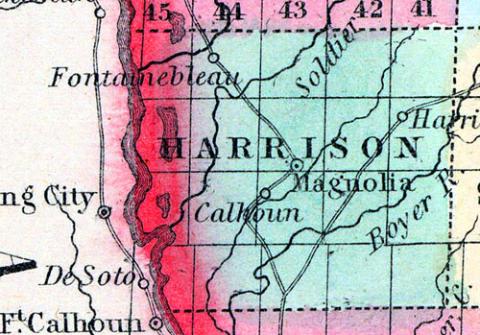HARRISON, a new county in the W. part of Iowa, bordering on the Mississippi river, has an area of about 480 square miles. The Missouri river forms its W. boundary, and it is intersected by the Boyer and Soldier rivers. It is not included in the census of 1850, and the population is very sparse. No seat of justice having been established, the county is attached to Pottawattomie for judicial purposes. (Baldwin's New and Complete Gazetteer of the United States..., 1854)
HARRISON COUNTY, Situated on the Missouri River, is but sparsely settled yet, less than one-fourth of the land in the county being entered. This county is well watered by the Boyer Biver, the Little Sioux, and various smaller streams, tributary to these and the Missouri. Magnolia is the county-seat, be- side which there is no other settlement of importance. (Iowa As It Is in 1855; A Gazetteer for Citizens..., 1855)
HARRISON COUNTY Is centrally situated in the western part of the State, and is bounded on the north by Monona county, on the east by Shelby, on the south by Pottawattamie, and on the west by the Missouri River. It was organized in 1853, and has now a population of 4,500 mostly farmers and stock raisers.
The general surface of the county is level. The Missouri River bottom extends back twelve miles, and the seven miles nearest the river is mostly covered with timber. The bottom lands on the Missouri and Boyer Rivers are considered extremely good for farming purposes. The table lands are gently rolling prairie with some timber. The timber is principally oak, black walnut, linn, elm, hackberry, hickory, ash and cottonwood.
The county is well watered by Pigeon Creek in the eastern part of the county, the Boyer River a little east of the centre flowing from the north-east to the south-west, the Willow River in the centre flowing a little south of west, the Soldier River in the western part flowing into the Missouri, about eight miles north of the southern boundary of the county, and the Little Sioux in the north-western portion of the county. These are all good mill streams, and have mills erected upon them. Six steam and water flouring mills, seven steam and water saw mills, and one woolen factory are erected and in process of erection.
There are fifteen townships in the county, viz: Boyer, Calhoun, Cass, Cincinnati, Clay, Harrison, Jackson, Jefferson, La Grange, Little Sioux, Magnolia, Raglan, St. John, Taylor and Union. The Sioux City and Council Bluffs, and the Cedar Rapids and Missouri River Railroads are located through the county.
The first settlers of the county were Silas Condit, Daniel Brown, two brothers by the name of Chase, Charles Lepenta, James Hardy, Dr. Robert McGovern, Andrew Allan and Jacob Patee. Stephen King was the first county judge, and P. G. Cooper, the first clerk. Andrew Allan erected the first saw mill, and L. D. Butler, the first flour mill. (Hair's Iowa State Gazetteer..., 1865)

